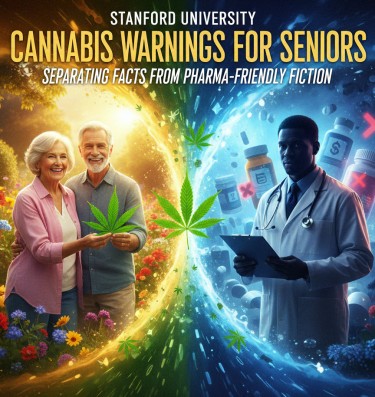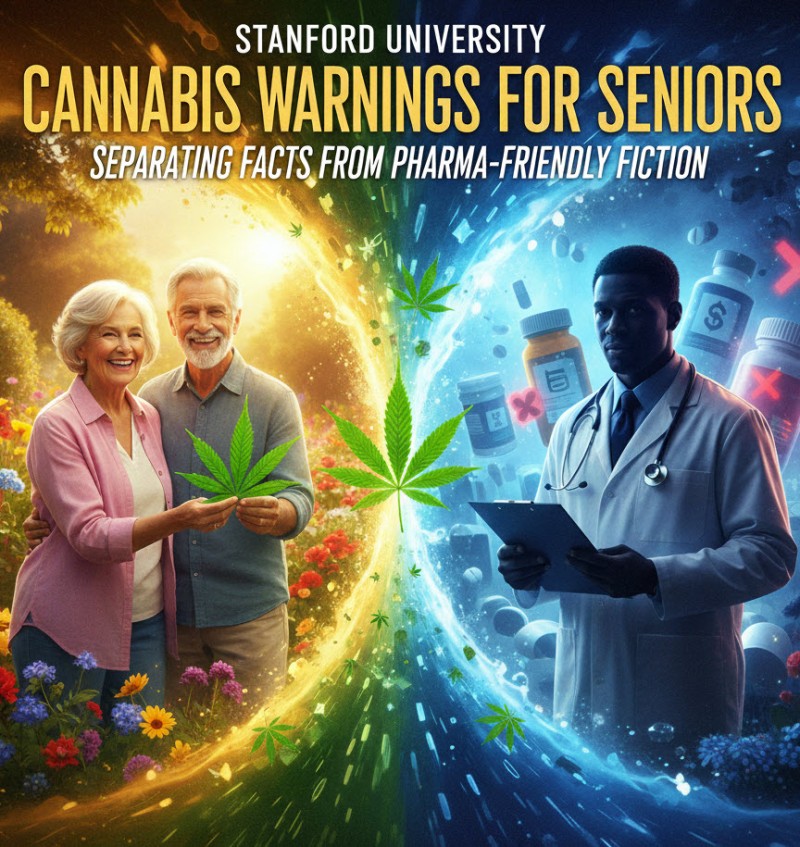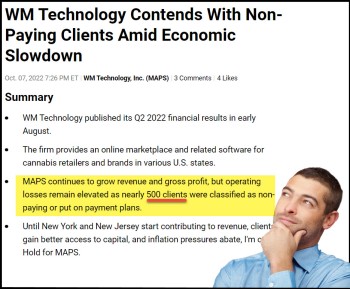
When I saw Stanford Medicine's article about cannabis use in older adults, I expected balanced, evidence-based health guidance. What I got instead was a mixture of legitimate medical advice wrapped in misleading statistics, historical revisionism, and barely disguised pharmaceutical industry talking points.
Don't get me wrong – warnings about cannabis use for seniors aren't inherently bad. Older adults do metabolize substances differently, and drug interactions with medications are real concerns worth discussing. But when prestigious institutions like Stanford start repeating debunked myths and cherry-picking data to paint cannabis as more dangerous than it actually is, we need to call it out.
The article presents five main points about cannabis and older adults, and while some contain nuggets of truth, others are so misleading they border on disinformation. Let's examine what Stanford got right, what they got spectacularly wrong, and why this matters for the millions of seniors exploring cannabis as an alternative to pharmaceuticals that have failed them.
The "Cannabis is Stronger Now" Myth That Won't Die
Stanford's first point claims marijuana in the 1970s contained between 1% and 4% THC, compared to today's 20% average. This is the "weak weed myth" that needs to be put to rest permanently, because it's based on fundamentally flawed data.
Yes, average commercial cannabis today is stronger than what most people smoked decades ago. But the claim that 1970s cannabis maxed out at 3-4% THC is provably false. Ask any old hippie who was actually there, and they'll tell you about strains like Acapulco Gold, Panama Red, Thai Stick, and original Kush varieties from Afghanistan that would absolutely wreck you.
The myth comes from police seizure records where cannabis sat in evidence rooms for months or years, exposed to light, heat, and air – conditions that rapidly degrade THC. When authorities finally tested these degraded samples, surprise! Low THC levels. This would be like leaving wine in the sun for six months and then declaring that all wine from that era was vinegar.
Hash and hash oil have existed for thousands of years with THC concentrations rivaling today's concentrates. Emerald Triangle growers in the 70s were producing incredibly potent cannabis through selective breeding and careful cultivation. The difference is that today's legal market makes high-potency products more widely available and consistently labeled, not that humans suddenly figured out how to make cannabis strong.
Stanford also lumps synthetic cannabinoids like K2 and Spice into their discussion of cannabis strength, which is intellectually dishonest bordering on malpractice. These synthetic compounds have completely different chemical structures from THC and were marketed as "legal marijuana" precisely because they aren't cannabis. Mentioning them in an article about cannabis is like discussing methamphetamine risks in an article about coffee – technically both are stimulants, but conflating them is ridiculous.
K2/Spice products have caused serious health problems including heart attacks and psychotic episodes. Cannabis has not. Conflating the two serves only to confuse readers and inflate perceived cannabis risks.
Heart Disease Claims Deserve Serious Scrutiny
Stanford's cardiologist Dr. Joseph Wu presents cannabis as a cardiovascular risk factor, citing studies showing 29% increased heart attack risk and 20% increased stroke risk among regular users. These are concerning numbers that deserve examination – but they also deserve context that Stanford conveniently omits.
First, Wu himself acknowledges that cannabis's cardiovascular effects "are lower than those associated with regular tobacco or excessive alcohol consumption." So why are we focusing institutional resources on warning seniors about cannabis while alcohol commercials dominate television and alcohol is available in every grocery store?
Second, the article notes that "those who use cannabis often also use tobacco, alcohol or both" and that combined use appears synergistic. This is a crucial confounding variable that makes attributing cardiovascular effects solely to cannabis scientifically problematic. If cannabis users also smoke cigarettes and drink alcohol, how do we know cannabis is the problem?
Third, and most importantly, the article completely ignores the massive body of research showing cannabis use is associated with reduced opioid use among chronic pain patients. Which poses greater cardiovascular risk: occasional cannabis use, or daily high-dose opioid consumption with its well-documented impacts on heart rhythm, respiratory depression, and overdose death?
The claim that "there is no safe amount of cannabis" for heart health deserves particular scrutiny. This absolutist language echoes prohibition-era rhetoric and contradicts Stanford's own expert who notes that "THC in very small doses can be therapeutic." Which is it – no safe amount, or therapeutic in small doses?
Regarding cancer risks, Stanford claims cannabis smoking is "linked to increased risk of lung and head and neck cancers" but provides no citations for this claim. Meanwhile, we have population-level data showing that places with high cannabis use don't show corresponding spikes in these cancers. Willie Nelson is 92 years old and has smoked cannabis daily for decades. Snoop Dogg, Tommy Chong, Woody Harrelson – all heavy, long-term cannabis users without the cancer epidemic these studies supposedly predict.
Correlation isn't causation, and when your predictions don't match real-world outcomes over decades, your correlations are probably spurious.
The 30% Addiction Rate Is Statistical Nonsense
Stanford's addiction psychiatrist Dr. Smita Das claims "around 30% of regular cannabis users have what is known as cannabis use disorder." This statement takes DSM-V criteria designed to pathologize normal behavior and presents it as medical fact.
The actual research shows cannabis use disorder rates around 9% among users – not 30%. That study Das references? It's measuring something very different from what most people think of as "addiction." The DSM-V criteria for cannabis use disorder include things like "spending a lot of time obtaining or using cannabis" (which describes literally anyone who uses regularly), "tolerance" (which develops to any regularly used substance including coffee), and "using more than intended" (which describes most people's relationship with Netflix, pizza, or social media).
By these criteria, 30% of coffee drinkers would have "caffeine use disorder," 40% of smartphone users would have "device use disorder," and probably 60% of people would have "food use disorder." The DSM-V is a pharmaceutical industry cookbook for prescribing medications, and its expanding definitions of "disorder" conveniently create more patients requiring pharmaceutical interventions.
Das "specializes in addiction psychiatry" – meaning her entire professional identity and income stream depends on finding and treating addiction. This represents a massive conflict of interest that Stanford should have disclosed. It's like asking a roofer if you need a new roof; the answer is always going to be yes.
The article also fails to distinguish between physical dependency and problematic use. Some regular cannabis users experience mild withdrawal symptoms (irritability, sleep disruption) when they stop, but these are nowhere near the severity of alcohol, benzodiazepine, or opioid withdrawal. Caffeine withdrawal is arguably worse than cannabis withdrawal, yet we don't see Stanford issuing dire warnings about coffee addiction in seniors.
The "Limited Research" Excuse Has Expired
Stanford's fourth point claims research on cannabis efficacy is limited, which would be a fair statement if we were living in 1995. We're not. We have decades of international research that the FDA simply refuses to acknowledge because of bureaucratic requirements designed to maintain pharmaceutical industry control.
The endocannabinoid system is well-studied. We understand how cannabinoids interact with CB1 and CB2 receptors. We have evidence from Israel, Canada, Europe, and other countries where research hasn't been systematically obstructed. The claim that we don't have sufficient evidence is only true if you arbitrarily dismiss all non-FDA-approved research – which is exactly what Stanford is doing.
Compare this to mRNA vaccines, which were researched, approved, and mandated in record time during COVID with far less long-term safety data than we have for cannabis. The FDA suddenly discovered urgency and flexibility in its approval process when pharmaceutical companies needed it. Where's that urgency for cannabis research that could help millions of chronic pain patients reduce opioid dependence?
Stanford's opposition to cannabis as medicine "in part because there is no evidence that it can effectively treat any psychiatric disorder" ignores extensive evidence for PTSD, anxiety, and depression treatment. The American Psychiatric Association's position that Das helped craft serves pharmaceutical interests, not patient interests. Psychiatry is essentially pharma's distribution arm at this point, so their opposition to a non-patentable plant medicine is predictable and self-serving.
What Stanford Actually Got Right
The article's final point – that seniors should discuss cannabis use openly with healthcare providers – is absolutely correct and possibly the only unambiguously good advice in the piece. Older adults do metabolize substances differently, drug interactions with blood thinners and other medications are real, and medical supervision makes sense.
The warnings about accidental overconsumption in edibles are also legitimate. Seniors unfamiliar with modern cannabis products can easily take too much, leading to uncomfortable (though not dangerous) experiences or unnecessary ER visits. This is a real problem requiring better education and clearer labeling.
The acknowledgment that cannabis helps some patients reduce opioid use is important, though Stanford buries this finding deep in the article rather than highlighting it as the potential public health benefit it represents.
The Real Story Stanford Won't Tell
What Stanford's article carefully avoids discussing is why cannabis remains federally prohibited despite overwhelming evidence of medical utility and relatively low risk compared to legal pharmaceuticals. They don't mention pharmaceutical industry lobbying against legalization. They don't acknowledge that cannabis threatens multi-billion-dollar markets for pain medications, sleep aids, and anxiety drugs.
Instead, we get selective statistics, historical revisionism, and warnings calibrated to make cannabis seem more dangerous than decades of real-world use suggests it actually is. This serves pharmaceutical interests while disserving seniors looking for alternatives to medications that have failed them or caused intolerable side effects.
Seniors deserve honest, evidence-based guidance about cannabis – including both potential benefits and genuine risks. What they don't deserve is prohibition-era propaganda dressed up as medical advice from prestigious institutions that should know better.







